As the sun rose over the lush, verdant landscape, the air was filled with a symphony of chirps, tweets, and trills. It was a morning like any other, yet a reminder of the incredible diversity of avian life. From the towering mountains to the sprawling grasslands, the sheer number of birds in the world is truly astounding.
According to the most extensive recent effort to estimate the number of birds worldwide, there are an estimated 50 billion total birds in the world. This means roughly six birds for every human. However, other studies have suggested a wide range, from 50 billion to 400 billion birds globally. The most populous wild bird species is the red-billed quelea, with a population of roughly 1.5 billion.
Key Takeaways
- The total estimated number of birds in the world is around 50 billion.
- Other studies have suggested a wide range of bird population estimates worldwide, varying between 50 billion and 400 billion birds.
- The red-billed quelea is the most populous wild bird species, with a population of around 1.5 billion birds.
- The domestic chicken has the largest population among bird species, with approximately 22 billion individuals.
- The study provides wide ranges of possible populations for thousands of bird species, quantifying the uncertainty in the estimates.
Counting Birds: A Complex Challenge
Counting the number of birds in the world is a big challenge. It needs advanced techniques and detailed data analysis. This is because counting birds is complex.
Counting Flocks and Estimating Large Numbers
One big challenge in counting birds is figuring out how many are in a flock. Researchers use methods like taking photos of birds in trees. They then divide the photos to count the birds. This helps them count flocks with thousands of birds.
To get a total count of birds, researchers use crowd-sourced reports and advanced analytics. They stress the need for accurate counting to understand bird species abundance.
“The guidance promotes providing estimates over just indicating presence, highlighting that an ‘X’ could represent a range of individuals from 1 to 1,000,000.”
Estimating bird populations is hard because of many factors. These include flock size, movement, species diversity, and habitat access. Techniques like flock size calculation and avian census techniques help overcome these issues.
The process of counting birds needs science, tech, and community help. Together, they provide accurate data on the world’s bird population.
How Many Bird Species Exist Globally?
Experts estimate there are between 9,500 and 11,000 bird species worldwide. This includes everything from common backyard birds to rare raptors and seabirds. The exact number could be higher, up to 18,000 to 20,000, thanks to genetic studies and new discoveries.
The Amazon rainforest alone is home to over 1,300 bird species, nearly 15% of all known birds. This shows there may be many more undiscovered birds in remote areas.
There are at least 50 billion wild birds globally, with six birds for every human. Four species have populations over 1 billion each. But, many bird species are in trouble, with half declining and 12% at risk of extinction.
Threats like habitat loss, climate change, and human activities are harming birds. This highlights the need for conservation efforts to protect these amazing creatures.
“The diversity of birds is truly astounding, and we are still uncovering the full extent of this global avian richness. As we continue to explore and study these remarkable creatures, our understanding of the number of bird species worldwide will likely continue to evolve.”
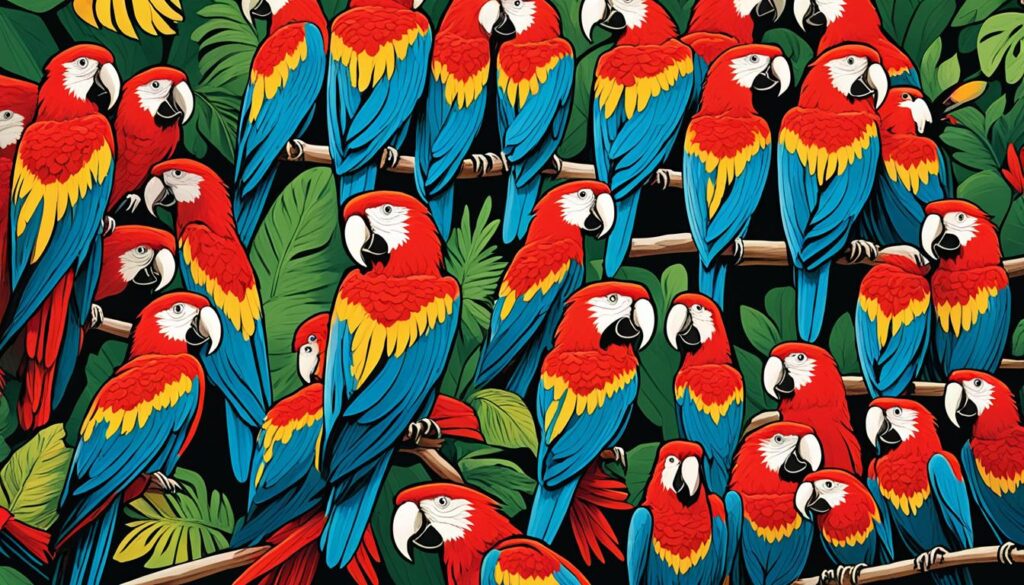
While we debate the exact number of bird species, it’s clear birds are crucial to our ecosystem. Their conservation is key to keeping our natural world balanced.
The Quest to Estimate the World’s Bird Population
Estimating the global bird population is a big task. A 2021 study brought new insights to this challenge. It used data from both professional science and citizen scientists. This gave us a better look at the world’s bird diversity.
Combining Professional and Citizen Science Data
A 2021 study estimated there are 50 billion birds worldwide. It used data from experts and eBird, a huge database of bird sightings from amateur birdwatchers. The results showed that professional and amateur bird counts were often similar. This helped scientists estimate bird populations for other species.
The study showed how important citizen science is. It helps fill data gaps and improves our understanding of birds worldwide.
- Events like the Big Garden Birdwatch in the UK and the Great Backyard Bird Count in the USA and Canada get lots of data from citizens.
- Joining these projects is good for your health and helps your community. It also teaches you about taking care of the environment.
- Using data from experts and amateurs is key to understanding the estimating global bird population, bird population data sources, and avian census methodologies.
Working together, professional scientists and citizen scientists have made big strides. They’ve filled in data gaps and improved our knowledge of bird population trends globally.
How Many Birds in the World? The Latest Estimate
In 2021, scientists made a big effort to count the world’s birds. They think there are 50 billion total birds. This number is on the lower side, but other estimates say there could be up to 400 billion birds. That means there could be 50 birds for every person on Earth.
The most abundant bird species is the House Sparrow, with 1.6 billion birds. The European Starling, Ring-billed Gull, and Barn Swallow also have huge populations, in the millions.
They used data from experts and regular people to count the birds. This included info from groups like Partners in Flight and BirdLife International. But, they say counting birds is tricky because we’re guessing at the numbers for thousands of species.
Even with the huge number of birds, experts are worried. They say we need to watch the bird populations closely. With 1,180 species (12% of the total) having fewer than 5,000 individuals, it’s clear we need to act fast to save them.
“The world population of domestic chickens is estimated to be around 25 billion, making them the most abundant bird species.”
This new count of birds gives us a lot to think about. It shows how important it is to protect our bird friends. As we learn more about our world, we see why saving birds is so crucial.
Birds Dominating the Ecosystem: The Billionaire Club
There are over 11,000 bird species worldwide, but a few stand out for their numbers. Four species have more than 1 billion birds each, making them part of ‘the billionaire club’. These include the house sparrow (1.6 billion), European starling (1.3 billion), ring-billed gull (1.2 billion), and barn swallow (1.1 billion). These most abundant bird species are key players in their ecosystem-shaping birds.
These avian population dominance species are found everywhere, from cities to countryside across the globe. Their large numbers help shape their ecosystems. They affect other species, energy flow, and how ecosystems work.
“These highly abundant bird species are the true movers and shakers of their environments, acting as keystone species that shape the dynamics of entire communities.”
The diversity of birds is amazing, but we must focus on these most abundant bird species. They have much bigger populations than many others. Understanding and managing these ecosystem-shaping birds is crucial for the health of the world’s birds.
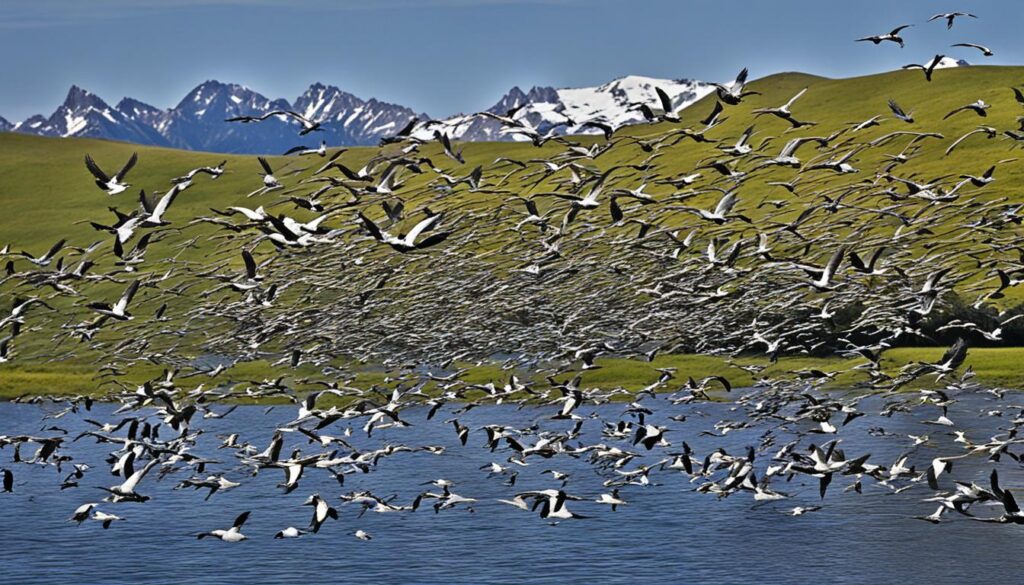
Rare and Endangered Bird Species
Some bird species are doing well, but many are in danger of disappearing. About 12% of the world’s birds have fewer than 5,000 individuals, making them very likely to vanish. These include the Chinese Crested Tern, Noisy Scrub-bird, and Invisible Rail.
The International Union for Conservation of Nature (IUCN) says if a bird has fewer than 2,500, it’s endangered. Over 1,480 bird species are threatened, with 223 at Critically Endangered risk of extinction soon.
Vulnerability to Extinction
One in eight of the world’s birds is at risk of going extinct. Threatened birds live all over the world, especially in tropical areas like the Andes, Brazil’s Atlantic Forest, and South-East Asia.
- Brazil and Indonesia have the most threatened bird species (122 and 119, respectively).
- Only 93 California condors are left in the wild as of 2020.
- About 200-250 northern bald ibises live in the wild in Morocco.
- Less than 50 Puerto Rican Amazons are thought to exist.
Bird populations can decline quickly and dramatically, affecting even species that were once common. Even a small increase in death rates can harm slow-breeding birds, leading to big population drops.
“Approximately 1 in 8 of the world’s bird species is at risk of extinction.”
The Methodology Behind the Global Bird Count
Counting all the birds in the world is a big job that needs many different steps. A key study in 2021 found there are about 50 billion birds. It used both professional and amateur birdwatcher data to get this number.
Experts from around the world provided three important datasets. These were combined with data from eBird, the biggest bird sighting database. This mix of data helped give a full view of birds worldwide.
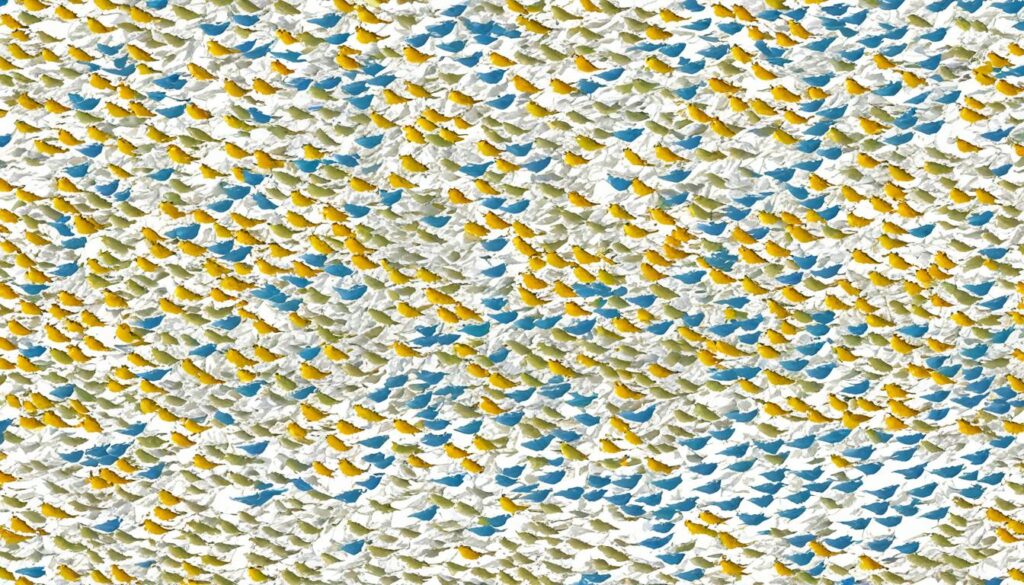
But they didn’t just stop there. The team used statistical modeling for bird counts for species with less data. This new method helped them understand the full range of global bird census techniques and the variety of birds out there.
This study changed what we thought we knew about the world’s birds. It shows how important it is to use both science and public help in counting and protecting birds. This way of collecting and analyzing data is key to understanding and helping our bird friends.
Avian Diversity: More Species Than Previously Thought?
For a long time, people thought there were about 11,000 bird species worldwide. But new research says this number might be way off. It could be as high as 18,000 or even 20,000.
A study by the American Museum of Natural History looked at 200 bird species at random. They found almost two distinct species for every bird type. This makes us think the old way of classifying birds might not be right anymore.
Redefining the Species Concept
The difference between the old count of 11,000 and the new estimate of 18,000 or more comes down to how we define species. Genetic studies show many birds thought to be one species are actually different ones. This means we need a new way to understand bird diversity.
These studies found over 600 new bird species, but they didn’t get official names yet. This hints at what’s to come in bird classification. As we learn more about bird genetics, the number of bird species is likely to keep going up. This will challenge what we thought we knew about bird diversity.
“The study suggests that we have been significantly underestimating the number of bird species in the world. As we refine our taxonomic understanding, we may find that there are many more species of birds than we previously thought.”
The Abundance of Birds Across Different Regions
The global distribution of bird populations is not even. Some places, like the Amazon rainforest, are full of birds, with over 1,300 species. This is nearly 15% of all birds in the world. Even tough places like Antarctica have birds like penguins and albatrosses. This shows how different places have different numbers of bird species.
Recently, scientists have made big strides in understanding where birds live and how many there are. They used over 36 million eBird checklists from 374,682 people. This helped them learn about 1,009 bird species and add 202 more this year. This info helps with conservation, research, and understanding bird populations.
“The visualizations provide detailed insights into the distribution and abundance of species globally, aiding in conservation initiatives and scientific research.”
New methods have helped us learn more about birds that stay in one place and don’t migrate. They used a whole year’s worth of data to see where these birds live and move. This was key for understanding the Blue Rock-Thrush in Eurasia, where over 6,000 eBirders helped fill in the gaps.
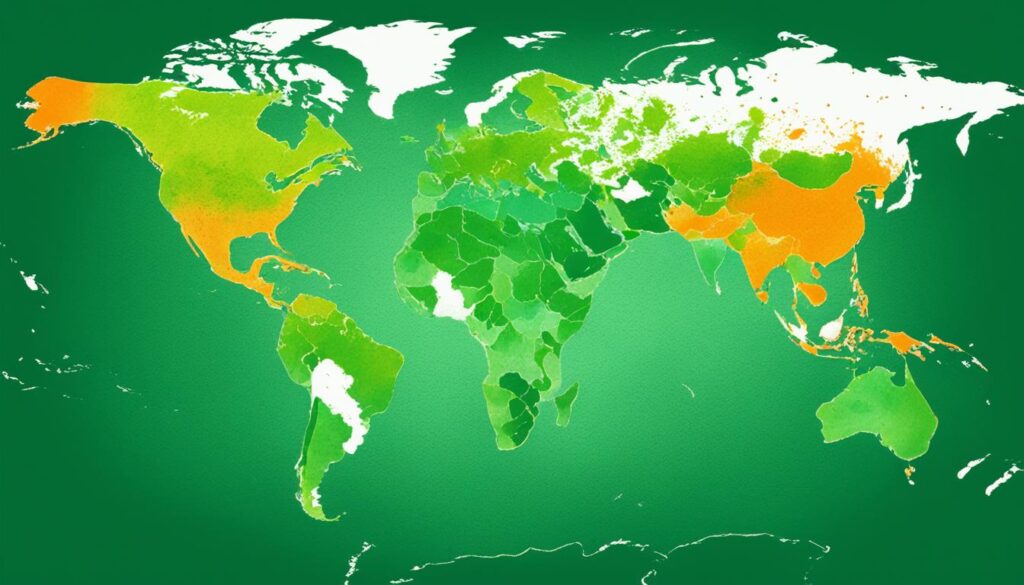
As we learn more about birds worldwide, these detailed datasets will help us protect them. They’ll also help us understand how birds adapt to a changing world.
Farmed Birds: A Separate Category
When we talk about the world’s birds, we must remember that the numbers don’t include domestic birds like farm chickens. In 2023, there were almost 35 billion domesticated chickens worldwide. These birds are counted separately from wild birds, which were the focus of a 2021 study that estimated 50 billion birds globally.
Adding domestic domestic bird populations would greatly increase the total number of birds. Farm-raised poultry and avian agriculture are key to our planet’s ecosystem. They help the farming industry in many ways.
- About 65% of farm birds eat plants and insects mostly outside the breeding season, compared to 90% in summer.
- Studies show that more bird species on farms can lower pest levels and sometimes increase crop yields. In a European apple orchard, more great tits meant fewer caterpillars and more apples per tree.
- Most studies on birds and farms show they are good for agriculture. They help control pests by eating insects.
Efforts to protect farm birds, like creating diverse habitats, help keep their populations stable. This balance is important for both domestic and wild birds.
“Increasing marginal land diversity has been shown to decrease insect pest damage and boost crop yield. Birds target pest insects, not beneficial ones, contributing significantly to pest control on farms.”
Understanding the value of domestic birds and their role in avian agriculture helps us see the big picture of the world’s bird population. It shows how wildlife and human-made environments are connected.
The Stark Reality: Declining Bird Populations Worldwide
Many bird species are in decline, putting their future at risk. The latest report shows half of all bird species are losing numbers, with only 6% increasing. Sadly, one in eight bird species, or 1,409, are at risk of extinction.
In North America, nearly 3 billion birds have vanished since 1970. The European Union has lost 600 million birds since 1980. These declines are due to habitat destruction, agricultural expansion and intensification, logging, climate change, and other human-driven impacts.
Threats Facing Bird Species
Birds face many threats. A big issue is the decline in insect populations, which birds need for food. Studies show a 9% drop in insects each decade, hurting birds that eat them.
Climate change is a big threat too. Migratory birds, like the whooping crane, are seeing changes in their migration routes. Birds like the Pied Flycatcher in Europe are struggling to find food because of climate change. By 2099, up to 16% of these specialist birds could be lost due to climate change.
The conservation status of birds is worrying. It shows we need to act fast to save these important birds and the ecosystems they support.
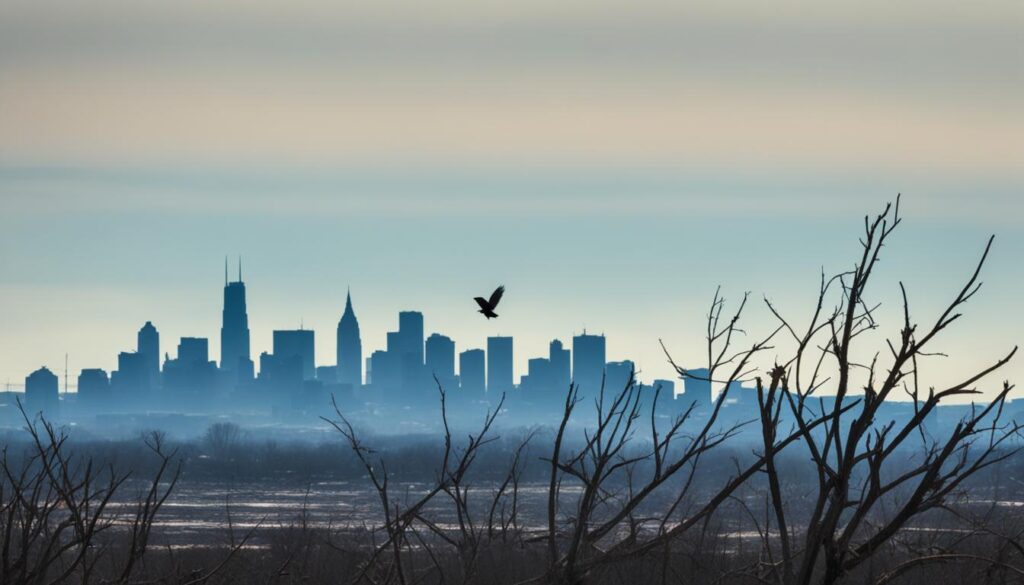
“The decline of insects globally is exerting significant impacts on multiple migratory insectivorous species, particularly birds and bat species.”
The Importance of Bird Conservation Efforts
Birds are key to keeping ecosystems balanced and healthy around the world. They help pollinate plants, control pests, and spread seeds far and wide. This is crucial for storing carbon in rainforests over time. But, the sharp drop in bird numbers is a big worry that needs quick action.
Protecting birds and their homes is vital for their survival and the health of their habitats. Targeted conservation efforts are needed to protect vulnerable and endangered bird species and reverse the trend of declining populations. By keeping bird populations safe, we help keep the ecosystem services they provide. These services are great for the environment and people too.
“Protecting avian biodiversity is crucial for the health and resilience of our planet’s ecosystems. Birds are the proverbial ‘canary in the coal mine’, alerting us to the urgent need for conservation action.”
Birds help by spreading seeds that keep rainforests alive and eating pests that would harm crops, reducing the need for dangerous pesticides. The ecosystem services provided by birds are huge. Bird conservation efforts must be a top priority, as these birds are key to our planet’s health.
Supporting bird conservation and living eco-friendly can help us all. By doing this, we can help protect avian biodiversity. This way, these important birds can keep thriving for many years to come.
How Many Birds in the World? A Surprising Answer
Scientists and nature lovers have always been curious about the number of birds on Earth. The latest count shows an astonishing 50 billion birds live here, which means about six birds for every human.
This number, given by top bird experts, shows how diverse and numerous birds are around the globe. But, the actual number of bird types might be even more, possibly around 18,000 or 20,000 different species.
Even though there are many birds, sadly, many species are in danger. They face threats like losing their homes, climate change, and harm from humans.
“The findings underscore the vital importance of ongoing conservation efforts to protect this vital component of global biodiversity.”
We need to keep working on saving birds to keep them around for the future. This will help these amazing creatures stay in our skies and make our lives richer.
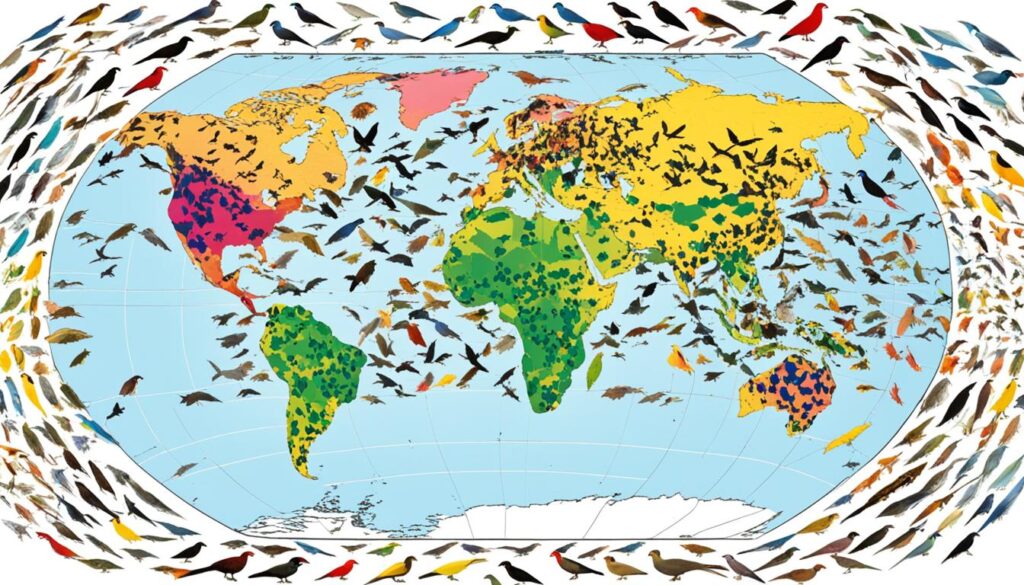
Conclusion
The search to understand the world’s bird populations has shown us both their huge numbers and the big declines. There are about 50 billion birds worldwide, with a few species leading ecosystems. But, many others are at high risk of disappearing. By using data from experts and everyday people, researchers have gotten a clearer picture of birds and their diversity.
It’s possible there are even more bird species than we know, which highlights the need for more research and protection. Keeping birds and their homes safe is key to keeping ecosystems healthy and strong. With many bird populations in North America facing big losses, we must act fast to protect these important creatures.
The study shows we urgently need to work on saving birds from threats like losing their homes, pesticides, and plastic pollution. By saving and boosting bird populations, we help biodiversity and keep ecosystems healthy for birds and many other living things.
FAQ
How many birds are there in the world?
Scientists estimate there are about 50 billion birds worldwide. This means roughly six birds for every person. But, some studies suggest there could be between 50 billion and 400 billion birds.
What is the most populous wild bird species?
The red-billed quelea is the most common wild bird, with around 1.5 billion birds.
How many bird species are there in the world?
There are over 11,000 bird species worldwide, according to most counts. But, some think there could be as many as 18,000 or 20,000 species.
How do researchers estimate the global bird population?
A 2021 study estimated 50 billion birds using a special method. It combined data from experts and amateur birdwatchers. They used three expert datasets and eBird, the biggest birdwatching database.
What is the distribution of bird species around the world?
Birds aren’t spread out evenly around the globe. The Amazon has over 1,300 bird species, nearly 15% of all birds. Even Antarctica has some bird species.
Are farmed birds included in the global bird population estimates?
No, the 50-400 billion bird estimate doesn’t include farmed birds like chickens. In 2023, there were nearly 35 billion domesticated chickens. These are counted separately from wild birds.
What are the threats facing bird populations worldwide?
Birds face threats like habitat loss, farming expansion, logging, climate change, and human impacts. The State of the World’s Birds report says half of bird species are declining. Only 6% are increasing, and one in eight are at risk of extinction.
Why is it important to conserve bird species and their habitats?
Birds are vital to ecosystems, helping with pollination, pest control, and seed dispersal. Their decline is a big worry. We need conservation efforts to protect endangered birds and reverse their decline.
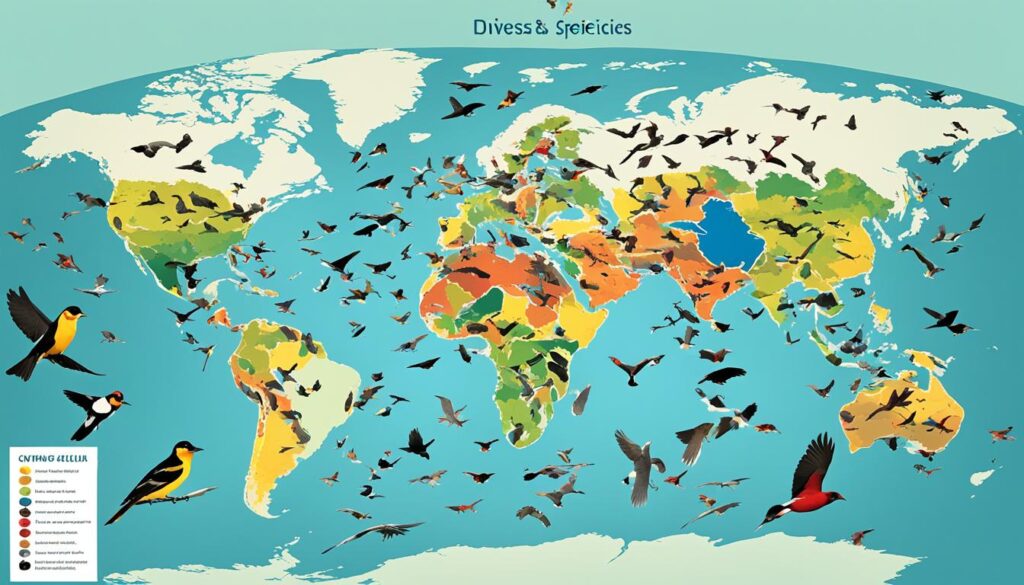

I am extremely inspired along with your writing talents and also
with the structure to your blog. Is that this a paid topic or did you customize it your self?
Either way keep up the nice high quality writing, it’s rare
to peer a great weblog like this one today. TikTok ManyChat!
услуги по продаже аккаунтов https://birzha-akkauntov-online.ru
маркетплейс аккаунтов маркетплейс аккаунтов
покупка аккаунтов безопасная сделка аккаунтов
продажа аккаунтов соцсетей https://ploshadka-prodazha-akkauntov.ru/
покупка аккаунтов маркетплейс аккаунтов
аккаунт для рекламы https://kupit-akkaunt-top.ru/
аккаунт для рекламы площадка для продажи аккаунтов
Buy and Sell Accounts Account trading platform
Buy Pre-made Account Account market
Account Trading Service Profitable Account Sales
Account Selling Platform Buy Pre-made Account
Accounts market Account Trading
Account exchange Secure Account Purchasing Platform
Ready-Made Accounts for Sale Account Acquisition
Social media account marketplace Account Selling Platform
Account market Secure Account Purchasing Platform
Website for Selling Accounts Website for Selling Accounts
Buy and Sell Accounts https://socialmediaaccountsale.com/
profitable account sales https://bestaccountsstore.com
account market secure account purchasing platform
account marketplace online account store
social media account marketplace account selling service
secure account sales buy and sell accounts
account buying platform account selling service
database of accounts for sale accounts marketplace
marketplace for ready-made accounts buy pre-made account
account buying service guaranteed accounts
profitable account sales find accounts for sale
account sale account buying platform
account exchange service account trading service
secure account purchasing platform profitable account sales
secure account purchasing platform account sale
find accounts for sale buy account
database of accounts for sale website for buying accounts
account buying platform account buying service
account catalog account catalog
account marketplace verified accounts for sale
account trading platform social media account marketplace
account trading platform account sale
sell account account buying platform
buy and sell accounts accounts for sale
account selling platform https://accounts-store.org/
profitable account sales secure account sales
verified accounts for sale https://shop-social-accounts.org/
secure account purchasing platform guaranteed accounts
profitable account sales https://accounts-offer.org
account acquisition https://accounts-marketplace.xyz
secure account sales https://buy-best-accounts.org
website for selling accounts https://social-accounts-marketplaces.live
find accounts for sale account market
account trading service social-accounts-marketplace.xyz
account trading account marketplace
guaranteed accounts accounts market
accounts market https://buy-accounts.live
account selling service https://social-accounts-marketplace.live
account buying service https://accounts-marketplace.online
account trading platform https://accounts-marketplace-best.pro
продать аккаунт https://akkaunty-na-prodazhu.pro
магазин аккаунтов https://rynok-akkauntov.top/
маркетплейс аккаунтов https://kupit-akkaunt.xyz
маркетплейс аккаунтов https://akkaunt-magazin.online/
купить аккаунт akkaunty-market.live
магазин аккаунтов https://kupit-akkaunty-market.xyz
маркетплейс аккаунтов https://akkaunty-optom.live/
продажа аккаунтов https://online-akkaunty-magazin.xyz
покупка аккаунтов https://akkaunty-dlya-prodazhi.pro/
маркетплейс аккаунтов https://kupit-akkaunt.online
buy facebook accounts for ads https://buy-adsaccounts.work
facebook accounts for sale https://buy-ad-accounts.click
facebook ad account buy buy facebook accounts cheap
buy facebook ads account https://buy-ads-account.click/
facebook account sale buy aged facebook ads accounts
buy facebook ads manager facebook ads account for sale
buy fb ad account facebook ads account for sale
buy facebook advertising accounts https://buy-ad-account.click
buy facebook accounts for advertising https://ad-accounts-for-sale.work
buy google ads invoice account google ads accounts
buy google ad threshold account https://buy-ads-accounts.click
sell google ads account https://ads-account-for-sale.top
buy google ad account https://ads-account-buy.work
buy google ads threshold accounts buy google ads verified account
buy google ads threshold account https://buy-account-ads.work
buy google ads verified account buy google ads threshold accounts
buy account google ads buy verified google ads accounts